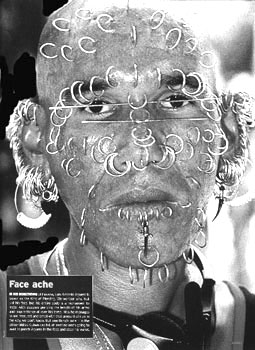|
1/2 second of pain…one little needle…one awesome piece of jewelry!
The trend sweeping the world is body piercing.
“Body piercing is a form of body modification that involves puncturing
the skin and placing a decorative object through the opening (http://www.dejanet.com)."
With body piercing on the rise, a lot of this group probably knows someone
who is pierced and just wonders what would compel him/her to do this.
I have spent $265 on my body piercings. I work hard while I am attending
school full-time, so I must really want them. Each piercing is different.
My first piercing was when I was seventeen years old. My mother had
to sign for me to have my navel pierced since I was not eighteen.
I was really scared, and my hands were cold and shaky. I have heard
that a good piercer can make the pain go away in half a second. So
far, all of this has been true for me personally. The short amount
of pain is far worth it for me to see this new addition to my appearance.
I still get nervous, and I still think about walking out, but I pull myself
together and clench my teeth for that second and it is over.
There are two common reasons that motivate people to get pierced.
The sensual affect drives many people to get pierced, the area becomes
increasingly more sensitive after healing and many people like the visual
affect of getting pierced. A friend of mine has spent $280 on piercing
his tongue, nipples, and fernum (skin under the male genital), he sees
it as a shock value.
 |
"people
are very surprised because I don’t look like
what
people would consider [to be] ‘the type,'"
(Jim, at the Voyeur)." |
I would say this is one of the reasons I get pierced. People get
an idea of how a person is and when they learn something contrary to this
belief, it makes them think more about who they are analyzing.
Now that we know why people get pierced, the next step is understanding
the actual piercing procedure...
First one decides what they want to get pierced, and who should perform
it. There are several questions one should ask the piercer:
Does the piercer have a professional, open and friendly attitude?
Do they use a sterile, disposable, single use needle?
Are the piercings performed in a special separate room?
Is the studio licensed with your local health department? (In many states,
the piercer must have some kind of medical background.)
Will the piercer provide advice on aftercare and make him/herself available
for further assistance if required? (Dr. Chann)
It is completely normal to be nervous about...
Going!
The worst time is when one gets out of the car, steps in to fill out the
necessary paperwork, and sits down in the room.
Pain.
Everyone asks “Did it hurt?” Yes it does, for a second.
When the needle goes in, a certain stress is released, and this, (not pain)
is what causes people to feel lightheaded. The most common response
is a quick “Aaah!” followed by a nervous giggle. A lot of adrenaline
masks any pain (Delaney).
 |
Gary
Miller,
the
photographer...
|
...has
been bitten
by
the piercing bug too... |
 |
After
the piercing is performed, the piercer should instruct the client on how
to take care of the new piercing and any risks of infection...
The best time to clean the piercing is in the shower because the water
runs down the body. Applying Dial anti-bacterial soap to your fingertips
and gently rubbing and rotating the ring/barbell and the wound is the appropriate
way to clean the piercing. Do not apply Neosporin, alcohol, peroxide
or any topical solution to piercing.
Do not touch or play with the piercing unless cleaning (Buddahs)
Some common problems associated with piercings after the procedure include...
Infection (prolonged redness, excessive secretions of yellow liquid)
Allergic reactions
Rejections
Keloids (scars)
Doctors say the most common complications of piercing are bleeding, local
infection, and (as reported in dental journals), oral piercings can lead
to toxic shock syndrome or least common, HIV. It is important to
remember these infections are not the norm, but rare.
Since this fad is on the rise, many clinicians will be confronted with
a medical emergency where the jewelry must be removed for radiography or
speedy treatment in the pierced area. The horrific fact I discovered
was only 6 in 28 emergency physicians surveyed knew how to remove the jewelry
used for piercing.
Though piercing has a few risks involved, overall, it can be quite pleasing
to the individual. If we know why people get pierced, what happens
during the procedure, and how to care for it, we will have an appreciation
for the process.
Everyone's body is beautiful. Piercing, like highlighting one’s hair,
getting breast implants, or tattoos, is about pleasing oneself with something
new about their overall appearance. 
If you're in the market wholesale jewelry, including wholesale sterling silver, then maybe Teeda.com is right for you.
Credits:
Buddah’s Body Art.
Piercing Care.
Jim, at the Voyeur.
Interview.
Delaney, Jim.
PRIME Magazine. “Piercing For Beginners”. Issue 3, September
26th, 1995
Clinician Reviews.
“When Body Jewelry Must Be Removed”. Issue February 2000
Chann, Doctor Laura.
(http.//www.adrchann.dynamic.com) |




